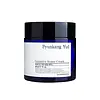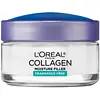What's inside
What's inside
 Key Ingredients
Key Ingredients

 Benefits
Benefits

 Concerns
Concerns

 Ingredients Side-by-side
Ingredients Side-by-side

Water
Skin ConditioningGlycerin
HumectantMethylpropanediol
SolventCaprylic/Capric Triglyceride
MaskingCetearyl Alcohol
EmollientMacadamia Ternifolia Seed Oil
EmollientHydrogenated Polydecene
EmollientButyrospermum Parkii Butter
Skin ConditioningGlyceryl Stearate
EmollientArachidyl Alcohol
EmollientBehenyl Alcohol
EmollientArachidyl Glucoside
EmulsifyingPhenyl Trimethicone
Skin ConditioningCetearyl Glucoside
EmulsifyingBeeswax
Emulsion StabilisingSorbitan Stearate
EmulsifyingCellulose Gum
Emulsion StabilisingCeramide NP
Skin ConditioningPaeonia Lactiflora Bark/Sap Extract
Skin ConditioningParfum
MaskingCornus Officinalis Fruit Extract
Skin ConditioningCurcuma Longa Root Extract
MaskingYeast Beta-Glucan
Skin ConditioningCopper Tripeptide-1
Skin ConditioningButylene Glycol
HumectantAloe Barbadensis Leaf Powder
Skin ConditioningHydrogenated Lecithin
EmulsifyingOctyldodecanol
EmollientCarbomer
Emulsion StabilisingHydroxyacetophenone
AntioxidantMyrtus Communis Extract
AstringentTropaeolum Majus Extract
AntimicrobialTromethamine
BufferingDisodium EDTA
Ethylhexylglycerin
Skin ConditioningWater, Glycerin, Methylpropanediol, Caprylic/Capric Triglyceride, Cetearyl Alcohol, Macadamia Ternifolia Seed Oil, Hydrogenated Polydecene, Butyrospermum Parkii Butter, Glyceryl Stearate, Arachidyl Alcohol, Behenyl Alcohol, Arachidyl Glucoside, Phenyl Trimethicone, Cetearyl Glucoside, Beeswax, Sorbitan Stearate, Cellulose Gum, Ceramide NP, Paeonia Lactiflora Bark/Sap Extract, Parfum, Cornus Officinalis Fruit Extract, Curcuma Longa Root Extract, Yeast Beta-Glucan, Copper Tripeptide-1, Butylene Glycol, Aloe Barbadensis Leaf Powder, Hydrogenated Lecithin, Octyldodecanol, Carbomer, Hydroxyacetophenone, Myrtus Communis Extract, Tropaeolum Majus Extract, Tromethamine, Disodium EDTA, Ethylhexylglycerin
Water
Skin ConditioningCyclohexasiloxane
EmollientGlycerin
HumectantButyrospermum Parkii Butter
Skin ConditioningIsohexadecane
EmollientPentaerythrityl Tetraethylhexanoate
EmollientDipropylene Glycol
HumectantCera Alba
EmollientStearic Acid
CleansingPalmitic Acid
EmollientCyclopentasiloxane
EmollientAcrylamide/Sodium Acryloyldimethyltaurate Copolymer
Emulsion StabilisingPEG-100 Stearate
Stearyl Alcohol
EmollientGlyceryl Stearate
EmollientPEG-20 Stearate
EmulsifyingBoswellia Serrata Extract
Skin ConditioningManganese Gluconate
Skin ConditioningSoluble Collagen
HumectantAtelocollagen
Skin ConditioningDimethiconol
EmollientPolysorbate 80
EmulsifyingPentaerythrityl Tetraisostearate
EmollientTocopherol
AntioxidantDisodium EDTA
Sodium Hydroxide
BufferingSilica Dimethyl Silylate
EmollientSodium Chondroitin Sulfate
Skin ConditioningPhenoxyethanol
PreservativeMethylparaben
PreservativeImidazolidinyl Urea
PreservativePotassium Sorbate
PreservativeParfum
MaskingAlpha-Isomethyl Ionone
PerfumingButylphenyl Methylpropional
PerfumingBenzyl Salicylate
PerfumingLinalool
PerfumingHexyl Cinnamal
PerfumingHydroxyisohexyl 3-Cyclohexene Carboxaldehyde
MaskingCitronellol
PerfumingWater, Cyclohexasiloxane, Glycerin, Butyrospermum Parkii Butter, Isohexadecane, Pentaerythrityl Tetraethylhexanoate, Dipropylene Glycol, Cera Alba, Stearic Acid, Palmitic Acid, Cyclopentasiloxane, Acrylamide/Sodium Acryloyldimethyltaurate Copolymer, PEG-100 Stearate, Stearyl Alcohol, Glyceryl Stearate, PEG-20 Stearate, Boswellia Serrata Extract, Manganese Gluconate, Soluble Collagen, Atelocollagen, Dimethiconol, Polysorbate 80, Pentaerythrityl Tetraisostearate, Tocopherol, Disodium EDTA, Sodium Hydroxide, Silica Dimethyl Silylate, Sodium Chondroitin Sulfate, Phenoxyethanol, Methylparaben, Imidazolidinyl Urea, Potassium Sorbate, Parfum, Alpha-Isomethyl Ionone, Butylphenyl Methylpropional, Benzyl Salicylate, Linalool, Hexyl Cinnamal, Hydroxyisohexyl 3-Cyclohexene Carboxaldehyde, Citronellol
 Reviews
Reviews

Ingredients Explained
These ingredients are found in both products.
Ingredients higher up in an ingredient list are typically present in a larger amount.
This ingredient is also known as shea butter. It is an effective skin hydrator and emollient.
Emollients help soothe and soften your skin. It does this by creating a protective film on your skin. This barrier helps trap moisture and keeps your skin hydrated. Emollients may be effective at treating dry or itchy skin.
Shea butter is rich in antioxidants. Antioxidants help fight free-radicals, or molecules that may harm the body. It is also full of fatty acids including stearic acid and linoleic acid. These acids help replenish the skin and keep skin moisturized.
While Shea Butter has an SPF rating of about 3-4, it is not a sunscreen replacement.
Shea butter may not be fungal acne safe. We recommend speaking with a professional if you have any concerns.
Learn more about Butyrospermum Parkii ButterDisodium EDTA plays a role in making products more stable by aiding other preservatives.
It is a chelating agent, meaning it neutralizes metal ions that may be found in a product.
Disodium EDTA is a salt of edetic acid and is found to be safe in cosmetic ingredients.
Learn more about Disodium EDTAGlycerin is already naturally found in your skin. It helps moisturize and protect your skin.
A study from 2016 found glycerin to be more effective as a humectant than AHAs and hyaluronic acid.
As a humectant, it helps the skin stay hydrated by pulling moisture to your skin. The low molecular weight of glycerin allows it to pull moisture into the deeper layers of your skin.
Hydrated skin improves your skin barrier; Your skin barrier helps protect against irritants and bacteria.
Glycerin has also been found to have antimicrobial and antiviral properties. Due to these properties, glycerin is often used in wound and burn treatments.
In cosmetics, glycerin is usually derived from plants such as soybean or palm. However, it can also be sourced from animals, such as tallow or animal fat.
This ingredient is organic, colorless, odorless, and non-toxic.
Glycerin is the name for this ingredient in American English. British English uses Glycerol/Glycerine.
Learn more about GlycerinGlyceryl Stearate is a mix of glycerin and stearic acid.
It is used to stabilize the mixing of water and oil ingredients. By preventing these ingredients from separating, it can help elongate shelf life. It can also help thicken the product's texture.
As an emollient, it helps soften skin and supports barrier-replenishing ingredients.
In cosmetics, Glyceryl Stearate is often made from vegetable oils or synthetically produced.
This ingredient may not be fungal-acne safe
Fun fact: The human body also creates Glyceryl Stearate naturally.
Learn more about Glyceryl StearateParfum is a catch-all term for an ingredient or more that is used to give a scent to products.
Also called "fragrance", this ingredient can be a blend of hundreds of chemicals or plant oils. This means every product with "fragrance" or "parfum" in the ingredients list is a different mixture.
For instance, Habanolide is a proprietary trade name for a specific aroma chemical. When used as a fragrance ingredient in cosmetics, most aroma chemicals fall under the broad labeling category of “FRAGRANCE” or “PARFUM” according to EU and US regulations.
The term 'parfum' or 'fragrance' is not regulated in many countries. In many cases, it is up to the brand to define this term.
For instance, many brands choose to label themselves as "fragrance-free" because they are not using synthetic fragrances. However, their products may still contain ingredients such as essential oils that are considered a fragrance by INCI standards.
One example is Calendula flower extract. Calendula is an essential oil that still imparts a scent or 'fragrance'.
Depending on the blend, the ingredients in the mixture can cause allergies and sensitivities on the skin. Some ingredients that are known EU allergens include linalool and citronellol.
Parfum can also be used to mask or cover an unpleasant scent.
The bottom line is: not all fragrances/parfum/ingredients are created equally. If you are worried about fragrances, we recommend taking a closer look at an ingredient. And of course, we always recommend speaking with a professional.
Learn more about ParfumWater. It's the most common cosmetic ingredient of all. You'll usually see it at the top of ingredient lists, meaning that it makes up the largest part of the product.
So why is it so popular? Water most often acts as a solvent - this means that it helps dissolve other ingredients into the formulation.
You'll also recognize water as that liquid we all need to stay alive. If you see this, drink a glass of water. Stay hydrated!
Learn more about Water